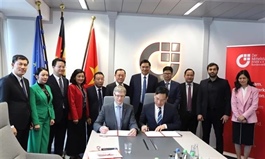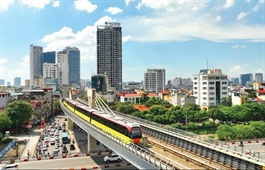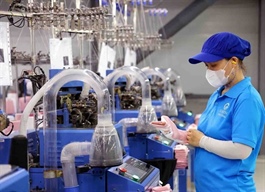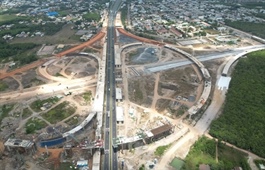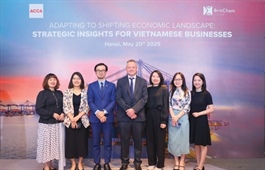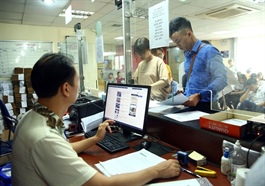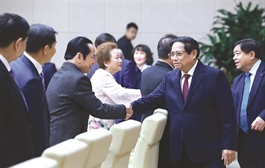Foreign direct investment continues to pour into Việt Nam
Foreign direct investment continues to pour into Việt Nam
These figures underlined Việt Nam’s rising status as a top global investment destination, especially amid shifting global supply chains and increasing trends in capital relocation.
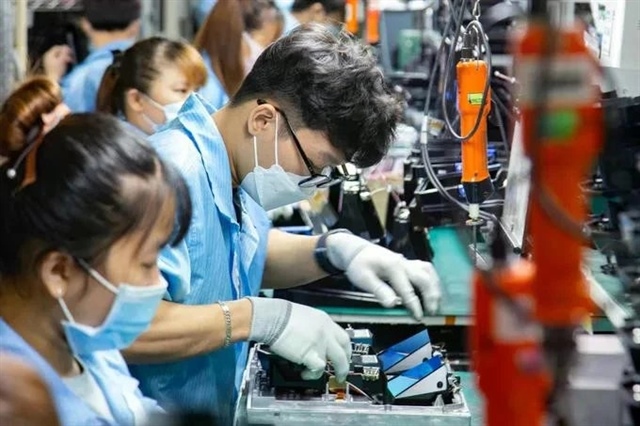
Assembling electronic equipment at Datalogic Việt Nam Factory. — Photo sggp.org.vn |
Việt Nam has attracted US$13.82 billion in newly registered foreign direct investment (FDI) since the beginning of this year, marking a nearly 40 per cent increase compared to the same period last year, while disbursed capital has reached $6.74 billion, the highest level recorded in the past five years, reflecting strong investor confidence in the Vietnamese market.
Surge in high-quality investment
These figures underlined Việt Nam’s rising status as a top global investment destination, especially amid shifting global supply chains and increasing trends in capital relocation.
Cấn Văn Lực, a member of the Prime Minister’s Policy Advisory Council, pointed out that Singapore currently leads among the 60 countries and territories investing in Việt Nam, with a total of $1.6 billion, accounting for 28.6 per cent of newly registered capital.
It is followed closely by China, which has invested $1.52 billion (27.1 per cent), and Japan, contributing $573.2 million (10.3 per cent). Within the disbursed capital structure, the manufacturing and processing industry dominated with 81 per cent, clearly aligning with Việt Nam’s policy to attract investment into high-tech and value-added sectors.
Beyond the increase in investment volume, economists are also noting a substantial improvement in the quality of FDI. Several large-scale, high-impact projects have been launched since the beginning of 2024.
Among these are Colourful Nylon Fiber synthetic yarn factory in Tây Ninh, estimated at $121 million; Tuyên Quang Erex biomass power plant from Japan, worth approximately $116 million; Sembcorp SIS Đình Vũ logistics centre (Phase 2) in Hải Phòng, valued at $49 million; and Mustang Battery factory in Long An, estimated at $47 million.
These projects span across diverse sectors, from renewable energy and supporting industries to logistics and advanced materials.
In HCM City, more than 13,600 FDI projects remain active, accounting for over 32 per cent of the country’s total and approximately 11.7 per cent of all registered FDI capital.
The city is aggressively planning 14 new industrial parks, covering a combined area of over 3,800 hectares, designed around modern, green, high-tech and specialised development models.
Gabor Fluit, Chairman of the European Chamber of Commerce in Việt Nam (EuroCham), noted that Việt Nam remains one of the most promising long-term markets in the region for European businesses. According to EuroCham’s latest Business Confidence Index (BCI), sentiment among European firms has improved, with the index rising to 46.3 points, reflecting a positive shift in investment outlook.
A separate survey by the Japan External Trade Organisation (JETRO) revealed that more than 56 per cent of Japanese companies operating in Việt Nam plan to expand their investments within the next one to two years. Stability in government policies and strong local support are key factors contributing to Japanese investors’ ongoing confidence in the Vietnamese market.
Foundation for investment expansion
Nguyễn Ngọc Hòa, Chairman of the HCM City Union of Business Associations (HUBA), emphasised that Việt Nam’s FDI achievements are closely tied to robust administrative reforms. These include simplifying investment procedures, embracing digital platforms to accelerate application processes and actively promoting favourable policies for investors.
Central and local authorities have worked together to implement reforms that build trust and reduce friction, laying a strong foundation for sustainable economic development.
Lực added that Việt Nam continues to strengthen its position through macroeconomic stability and institutional reforms. He highlighted the government’s four-pronged strategic approach, which includes digital transformation and science-technology development (Resolution 57), international economic integration (Resolution 59), institutional reform (Resolution 66) and private sector development (Resolution 68).
Of particular note, Resolution 68 aims to create more room for private enterprises by safeguarding three core rights: market access, resource access and property rights. These not only support domestic entrepreneurship but also help create a more attractive investment climate for foreign capital.
The Government is also pushing to resolve 2,200 delayed public investment projects, with a combined value nearing VNĐ5.9 quadrillion ($277.71 billion), equivalent to roughly 50 per cent of the country's GDP.
According to Lực, if these projects are successfully disbursed, GDP growth could receive an additional 1 to 2 percentage points. Faster public investment rollout not only boosts total demand but also generates a ripple effect that stimulates both the private sector's activities and FDI, particularly at a time when businesses are seeking stability in the aftermath of the COVID-19 pandemic and ongoing global trade tensions.
To maintain long-term competitiveness, Gabor Fluit stressed that Việt Nam must continue to simplify administrative procedures and invest in workforce development.
Streamlining investment licensing, customs clearance and other business processes would significantly improve operational efficiency. At the same time, strengthening training programmes for high-skilled labourers will be critical to meeting the growing demands of high-tech and modern manufacturing industries.
With solid macroeconomic fundamentals, an ambitious reform agenda and consistent support from administrations at all levels, Việt Nam is well-positioned to remain a strategic destination for global investment, particularly as supply chains continue to shift in the post-pandemic period.
- 21:42 26/05/2025



